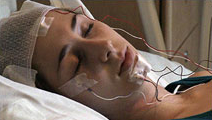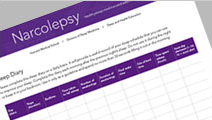The Takeaway
- Sleep studies can provide information about how you sleep. These studies usually include an overnight stay followed the next day by a series of five daytime naps in a sleep laboratory.
- Before the tests, it is important to get sufficient sleep on a regular schedule and to discontinue any medications that can affect sleep.
- In people with narcolepsy, the sleep studies usually provide clear evidence of sleepiness and abnormal patterns of REM sleep.
If a doctor suspects narcolepsy, he or she will likely recommend sleep studies. These tests are essential to provide clear evidence of sleepiness, to examine the pattern of rapid-eye-movement (REM) sleep, and to determine whether other disorders might be contributing to a patient’s symptoms.

Types of Sleep Tests
Testing usually consists of an overnight stay in a sleep laboratory for a test called a polysomnogram, followed the next day by the Multiple Sleep Latency Test (commonly known as the MSLT).A polysomnogram is a recording of brain waves, eye movements, muscle tone, and breathing across a night of sleep. In people with narcolepsy, the polysomnogram is done to evaluate the amount and quality of nighttime sleep and to look for any evidence of an additional sleep disorder (for example, sleep apnea or periodic limb movements in sleep).
The Multiple Sleep Latency Test is often the most important test for diagnosing narcolepsy. It is a series of five scheduled naps spread across the day. Every two hours, the patient is given an opportunity to sleep for 20 minutes or more. The MSLT is done the day after the polysomnogram so a doctor can determine whether the prior night’s sleep could be affecting the daytime naps.
Dr. Scammell describes how a polysomnogram
and a multiple sleep latency test (MSLT)
are used in diagnosing narcolepsy.
Preparing for Sleep Tests
The polysomnogram and MSLT can be disrupted by a variety of factors, so it is important to get clear instructions on how to prepare for these tests.
A doctor will usually recommend that a patient stop, one to three weeks prior to the tests, any medications that can affect the brain. This is especially important for medications used to treat depression, drugs that increase alertness, and drugs that have the potential for abuse or addiction, such as amphetamines or cocaine.
It is important to obtain enough sleep before the tests. A doctor may request that a patient keep a sleep diary for one to two weeks before the tests to be certain that insufficient sleep is not a contributing factor. Download the printable Sleep Diary (PDF) to track your sleeping patterns. During this period the doctor might also want to measure a patient's activity using a technique known as wrist-based actigraphy. For this, the patient is asked to wear a device resembling a wristwatch that records body movements to estimate amounts of sleep.
Dr. Maski explains the value of using a sleep diary.
If someone has a tendency to routinely sleep later than 8 a.m., the doctor may recommend changes to the sleep schedule or timing of the sleep tests.
Understanding test results

The polysomnogram may also show that an individual dozes off in less than five minutes or has greater-than-normal amounts of light non-REM sleep, but these phenomena are not decisive for a diagnosis. This test is also helpful in identifying any additional sleep disorders (for example, sleep apnea or periodic limb movements in sleep) that could contribute to poor quality sleep.
If someone has narcolepsy, the MSLT usually reveals that the person falls asleep rapidly (in less than eight minutes on average across the naps) and enters REM sleep during two or more naps. This pattern on the MSLT is considered highly suggestive of narcolepsy. In contrast, most people without narcolepsy take much longer to fall asleep during naps, and if they do fall asleep, they rarely enter REM sleep. The MSLT results can highlight two major indicators of narcolepsy:
- People with narcolepsy can fall asleep quickly, even after a good night’s sleep.
- People with narcolepsy have impaired regulation of REM sleep. Normally, REM sleep occurs only during the night, but in people with narcolepsy, it can occur at any time of day.
Sometimes the results of the MSLT are unclear, and a doctor may recommend repeating the test if he or she thinks narcolepsy is likely.
Other tests

recommend checking spinal fluid
for evidence of hypocretin loss.
Although this test is considered
experimental, it may become more
widely available in the future.
Occasionally a doctor may recommend checking the level of hypocretin-1 in the spinal fluid. This test is very specific for narcolepsy, as hypocretin levels are low in almost no other condition. The test requires a lumbar puncture (spinal tap) to collect the fluid, and can make the diagnosis much clearer in some children, in adults who have unusual cataplexy, and in anyone who cannot discontinue medications that interfere with the MSLT. This test is now available through Mayo Labs.
Although most people who have narcolepsy carry a genetic marker (HLA-DQB1*06:02) associated with the disorder, this gene is only a predisposing factor to developing narcolepsy. Testing for it will not confirm a diagnosis of the disorder. In fact, this gene is moderately common in the general population, so it provides only modest diagnostic evidence. Still, some doctors find the test helpful when symptoms are atypical.
References
- Andlauer O, Moore H, Jouhier L, Drake C, Peppard PE, Han F, Hong SC, Poli F, Plazzi G, O'Hara R, Haffen E, Roth T, Young T, Mignot E. Nocturnal rapid-eye-movement sleep latency for identifying patients with narcolepsy/hypocretin deficiency. JAMA Neurol 2013; 70:891–902.